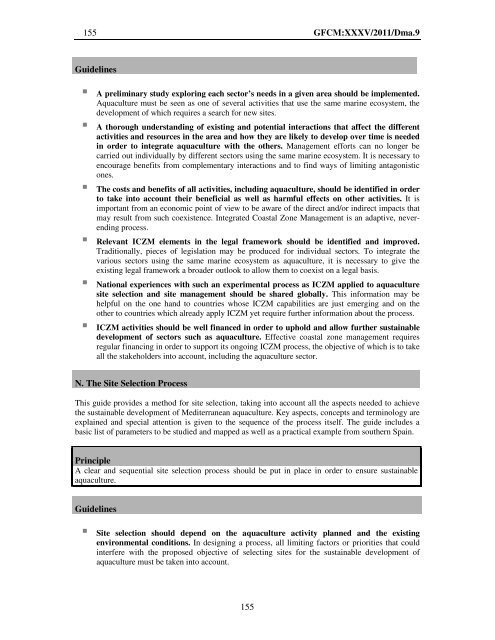Site selection and carrying capacity in Mediterranean ... - FAO Sipam
Site selection and carrying capacity in Mediterranean ... - FAO Sipam
Site selection and carrying capacity in Mediterranean ... - FAO Sipam
You also want an ePaper? Increase the reach of your titles
YUMPU automatically turns print PDFs into web optimized ePapers that Google loves.
155 GFCM:XXXV/2011/Dma.9<br />
Guidel<strong>in</strong>es<br />
A prelim<strong>in</strong>ary study explor<strong>in</strong>g each sector’s needs <strong>in</strong> a given area should be implemented.<br />
Aquaculture must be seen as one of several activities that use the same mar<strong>in</strong>e ecosystem, the<br />
development of which requires a search for new sites.<br />
A thorough underst<strong>and</strong><strong>in</strong>g of exist<strong>in</strong>g <strong>and</strong> potential <strong>in</strong>teractions that affect the different<br />
activities <strong>and</strong> resources <strong>in</strong> the area <strong>and</strong> how they are likely to develop over time is needed<br />
<strong>in</strong> order to <strong>in</strong>tegrate aquaculture with the others. Management efforts can no longer be<br />
carried out <strong>in</strong>dividually by different sectors us<strong>in</strong>g the same mar<strong>in</strong>e ecosystem. It is necessary to<br />
encourage benefits from complementary <strong>in</strong>teractions <strong>and</strong> to f<strong>in</strong>d ways of limit<strong>in</strong>g antagonistic<br />
ones.<br />
The costs <strong>and</strong> benefits of all activities, <strong>in</strong>clud<strong>in</strong>g aquaculture, should be identified <strong>in</strong> order<br />
to take <strong>in</strong>to account their beneficial as well as harmful effects on other activities. It is<br />
important from an economic po<strong>in</strong>t of view to be aware of the direct <strong>and</strong>/or <strong>in</strong>direct impacts that<br />
may result from such coexistence. Integrated Coastal Zone Management is an adaptive, neverend<strong>in</strong>g<br />
process.<br />
Relevant ICZM elements <strong>in</strong> the legal framework should be identified <strong>and</strong> improved.<br />
Traditionally, pieces of legislation may be produced for <strong>in</strong>dividual sectors. To <strong>in</strong>tegrate the<br />
various sectors us<strong>in</strong>g the same mar<strong>in</strong>e ecosystem as aquaculture, it is necessary to give the<br />
exist<strong>in</strong>g legal framework a broader outlook to allow them to coexist on a legal basis.<br />
National experiences with such an experimental process as ICZM applied to aquaculture<br />
site <strong>selection</strong> <strong>and</strong> site management should be shared globally. This <strong>in</strong>formation may be<br />
helpful on the one h<strong>and</strong> to countries whose ICZM capabilities are just emerg<strong>in</strong>g <strong>and</strong> on the<br />
other to countries which already apply ICZM yet require further <strong>in</strong>formation about the process.<br />
ICZM activities should be well f<strong>in</strong>anced <strong>in</strong> order to uphold <strong>and</strong> allow further susta<strong>in</strong>able<br />
development of sectors such as aquaculture. Effective coastal zone management requires<br />
regular f<strong>in</strong>anc<strong>in</strong>g <strong>in</strong> order to support its ongo<strong>in</strong>g ICZM process, the objective of which is to take<br />
all the stakeholders <strong>in</strong>to account, <strong>in</strong>clud<strong>in</strong>g the aquaculture sector.<br />
N. The <strong>Site</strong> Selection Process<br />
This guide provides a method for site <strong>selection</strong>, tak<strong>in</strong>g <strong>in</strong>to account all the aspects needed to achieve<br />
the susta<strong>in</strong>able development of <strong>Mediterranean</strong> aquaculture. Key aspects, concepts <strong>and</strong> term<strong>in</strong>ology are<br />
expla<strong>in</strong>ed <strong>and</strong> special attention is given to the sequence of the process itself. The guide <strong>in</strong>cludes a<br />
basic list of parameters to be studied <strong>and</strong> mapped as well as a practical example from southern Spa<strong>in</strong>.<br />
Pr<strong>in</strong>ciple<br />
A clear <strong>and</strong> sequential site <strong>selection</strong> process should be put <strong>in</strong> place <strong>in</strong> order to ensure susta<strong>in</strong>able<br />
aquaculture.<br />
Guidel<strong>in</strong>es<br />
<strong>Site</strong> <strong>selection</strong> should depend on the aquaculture activity planned <strong>and</strong> the exist<strong>in</strong>g<br />
environmental conditions. In design<strong>in</strong>g a process, all limit<strong>in</strong>g factors or priorities that could<br />
<strong>in</strong>terfere with the proposed objective of select<strong>in</strong>g sites for the susta<strong>in</strong>able development of<br />
aquaculture must be taken <strong>in</strong>to account.<br />
155
















